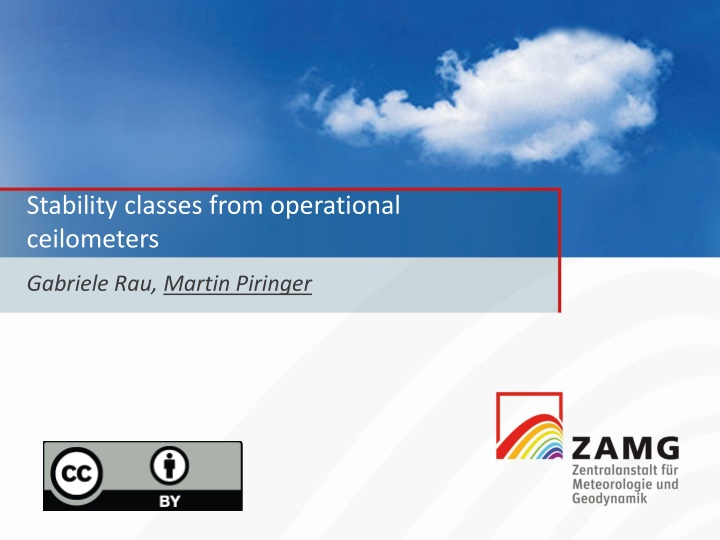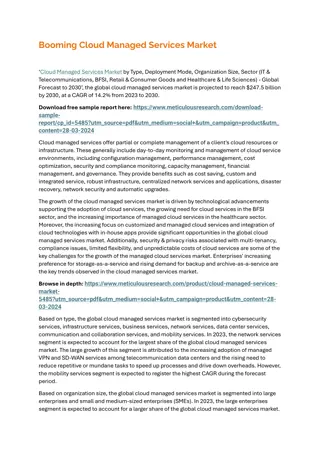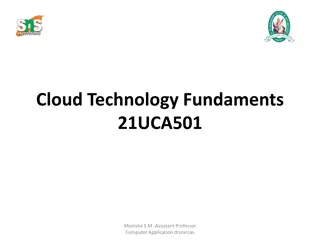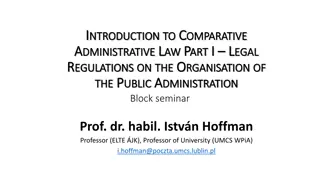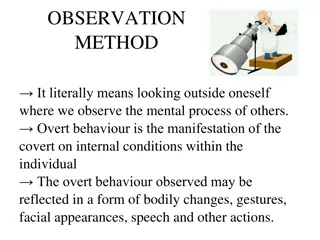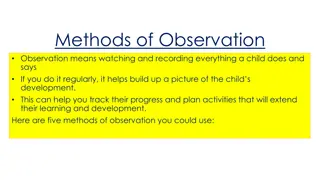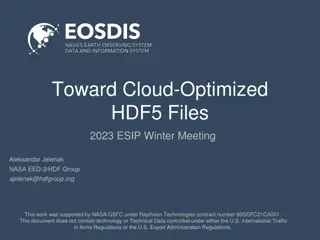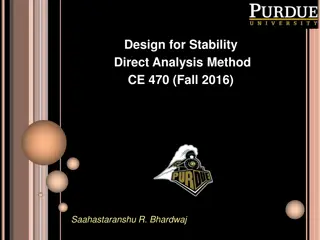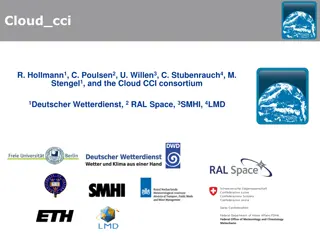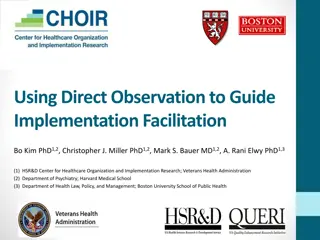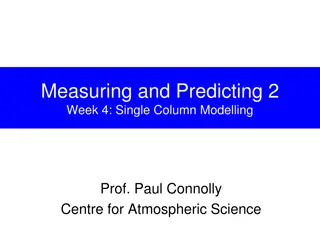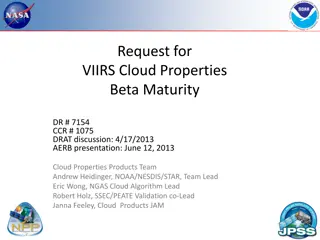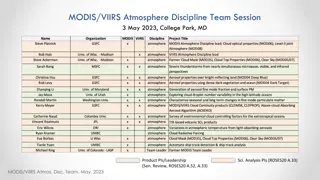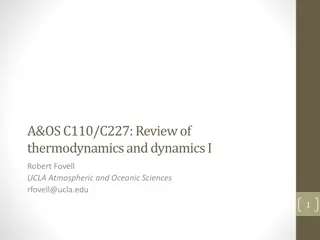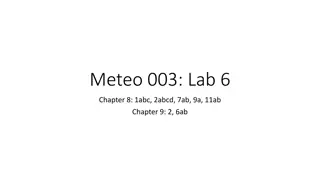Comparison of Cloud Observation Methods for Atmospheric Stability Analysis
Investigating the use of ceilometers to determine stability classes based on cloud cover data, comparing results with human observations. The study aims to assess the feasibility of substituting ceilometer data for human cloud coverage observations in determining atmospheric stability. Results show discrepancies in cloudiness estimation between human observers and ceilometers, highlighting the potential of automated instruments in meteorological studies.
Download Presentation

Please find below an Image/Link to download the presentation.
The content on the website is provided AS IS for your information and personal use only. It may not be sold, licensed, or shared on other websites without obtaining consent from the author.If you encounter any issues during the download, it is possible that the publisher has removed the file from their server.
You are allowed to download the files provided on this website for personal or commercial use, subject to the condition that they are used lawfully. All files are the property of their respective owners.
The content on the website is provided AS IS for your information and personal use only. It may not be sold, licensed, or shared on other websites without obtaining consent from the author.
E N D
Presentation Transcript
Stability classes from operational ceilometers Gabriele Rau, Martin Piringer
Outline 06.10.2024 Folie 2 Motivation Stability classes from human cloud cover observations Stability classes from ceilometer using cloud base height information Results: Comparison of stability classes Summary of findings
Motivation 06.10.2024 Folie 3 Dispersion models usually need atmospheric stability information as a meteorological input parameter Klug-Manier scheme used here (German AKTerm- format) Stability classes from cloud coverage data is one of the most often used schemes for the parameterization The number of fully automatic meteorological stations (without human observations) is increasing Methods other than human observations to quantify cloud coverage e.g. based on instruments such as ceilometers will come into use, despite the different approaches of how to define cloud cover CL51 at ZAMG
Aim of the investigation 06.10.2024 Folie 4 A human observer will take into account the whole visible sky A ceilometer can only detect clouds directly above the instrument, but with a high temporal resolution Can the mean value of ceilometer soundings over a defined period of time (i.e. an hour) be used as a substitute for observed cloud coverage data in order to determine stability classes? At 4 sites in Austria Klug-Manier-classes derived from observed cloud data (for the year 2014) were compared with Klug-Manier-classes from ceilometer data At one site (ZAMG at Vienna), a single ceilometer CL51 is in use, at the airports (AustroControl) several (up to five instruments) ceilometers (CL31) can be combined to improve the cloud cover information
Cloudiness from Ceilometers Ceilometer does not deliver total cloud cover, but cloud cover from up to 3 single layers where clouds are detected (sky-condition-algorithm of manufacturer) 06.10.2024 Folie 5 At airports, data of more than one ceilometer can be combined to decrease the effect of a point measurement Two algorithms for total cloud cover from ceilometers were tested (for CL51 only): Total cloud cover = Max. of observed cloud cover (CeiloMax). This method was used for all further investigations Total cloud cover = Sum of observed cloud cover from all layers (CeiloSum)
Cloudiness - human observation vs. ceilometer 06.10.2024 Folie 6 Independent of site: Ceilometer over-estimates 0/8 and 8/8 cloudiness Ceilometer under-estimates 2/8 to 7/8, partly over- and underestimates 1/8 This is a result of observer instructions: 0/8 only, if there is no visible cloud; 8/8 only, if there is no visible cloud-free space Amount of agreement: 36 to 40 %; +/- 1 okta: ~ 70 %
Definition of Klug-Manier stability classes 06.10.2024 Folie 7 Klug-Manier classes are numbered from I to V and are classified according to atmospheric stability as follows: Stability classes V and IV comprise very unstable and unstable conditions, meaning good vertical mixing in the boundary layer. They do not occur during night-time. Class V occurs only between May and September. Stability classes III/2 and III/1 are classified as neutral. III/2 occurs predominantly at daytime, III/1 predominantly at night-time and during sunrise and sunset. These classes are typical for cloudy and/or windy conditions. Stability classes II and I comprise stable and very stable conditions, mostly, but not exclusively at night. They occur with reduced vertical mixing; horizontal transport over long distances is possible.
Basic scheme to determine Klug-Manier stability classes 06.10.2024 Folie 8 Wind velocity at a height of 10m (z0 = 0,1 m) ***) in ms-1 < 1,3 1,3 to 2,3 2,4 to 3,3 3,4 to 4,3 4,4 Total cloud coverage in oktas *) for night-time hours **) for day-time hours **) 0/8 to 6/8 I I II III/1 III/1 7/8 to 8/8 II II III/1 III/1 III/1 0/8 to 2/8 IV IV IV IV III/2 3/8 to 5/8 IV IV IV III/2 III/1 6/8 to 8/8 IV III/2 III/2 III/2 III/1 For *), **) and ***) several additional rules apply. Depending on the season a variety of further adaptations have to be considered. The stability class is determined for each hour via wind speed, cloud cover, base height of cloud as well as month and daytime Low wind speed, low cloud cover: stable during night, unstable during daytime High wind speed, high cloud cover: neutral day and night
Results: comparison of stability classes for Vienna 06.10.2024 Folie 9 Agreement observation to ceilometer: 84% (ZAMG) to 86.6 % (Airport)
Results: comparison of stability classes for Linz 06.10.2024 Folie 10 Agreement observation to ceilometer: 86.2%
Results: comparison of stability classes for Salzburg 06.10.2024 Folie 11 Agreement observation to ceilometer: 88.1%
Details of the comparison I 06.10.2024 Folie 12 percent 100 6,7 84,0 7,7 98,5 Vienna / ZAMG - observation I 2367 585 186 3108 1 106 0 0 0 2554 3801 year 2014 I II III/1 III/2 IV V sum II III/1 15 406 6111 434 56 19 7041 III/2 0 24 91 1876 448 129 2568 IV 0 0 7 79 797 181 1064 V 0 0 1 16 21 452 490 sum 2967 3724 6317 2407 1322 781 17518 number of cases 17518 1182 14711 1355 17248 available 1 category above trace 1 category below difference within 1 category CeiloMax 2 0 0 Vienna / Airport - observation I II 2742 321 264 3135 21 84 7 5 0 0 0 0 3034 3545 year 2014 I II III/1 III/2 IV V sum III/1 11 263 5963 442 32 13 6724 III/2 2 9 108 1912 379 109 2519 IV 0 1 2 60 908 189 1160 V 0 0 0 6 16 514 536 sum 3076 3672 6178 2432 1335 825 17518 number of cases 17518 768 15174 1358 17300 percent 100 4,4 86,6 7,8 98,8 available 1 category above trace 1 category below difference within 1 category Ceilo ACG Upper table: Vienna/ZAMG, one ceilometer CL51 Lower table: Vienna/Airport, several ceilometers CL31 Causes of good agreement: cloudiness and wind speed are split into only a few classes, wind speed data are the same
Details of the comparison II 06.10.2024 Folie 13 Linz / Airport - observation I 4180 740 5231 21 3 15 0 4959 5918 year 2014 I II III/1 III/2 IV V sum II III/1 14 245 1517 5 0 0 1781 III/2 8 3 7 1542 208 28 1796 IV 2 2 0 152 1773 174 2103 V 0 1 0 23 87 850 961 sum 4779 6222 1656 1726 2083 1052 17518 number of cases 17518 1066 15093 1238 17397 percent 100 6,1 86,2 7,1 99,3 575 available 1 category above trace 1 category below difference within 1 category Ceilo ACG 111 1 0 0 Salzburg / Airport - observation I II 4409 374 707 5502 9 68 2 3 0 0 0 0 5127 5947 year 2014 I II III/1 III/2 IV V sum III/1 6 200 1392 19 0 0 1617 III/2 5 4 11 1253 188 26 1487 IV 4 0 0 128 2084 162 2378 V 1 0 0 6 sum 4799 6413 1480 1411 2442 974 17519 number of cases 17519 883 15426 1144 17453 percent 100 5,0 88,1 6,5 99,6 available 1 category above trace 1 category below difference within 1 category Ceilo ACG 170 786 963 Very good agreement for the airports at Linz (upper table) and Salzburg (lower table)
Interpretation 06.10.2024 Folie 14 A good agreement between stability classes from visual cloudiness observations and ceilometer-derived cloudiness is obtained In 84 to 88 % of all cases, the same stability class is determined The agreement of stability classes is better than that of the cloud information This result is to be expected as the cloudiness and wind speed data are summarized to only a few classes Ceilometer cloud information can be used equally well as visual observation to determine stability classes
06.10.2024 Folie 15 Thank you for your attention! Questions?
